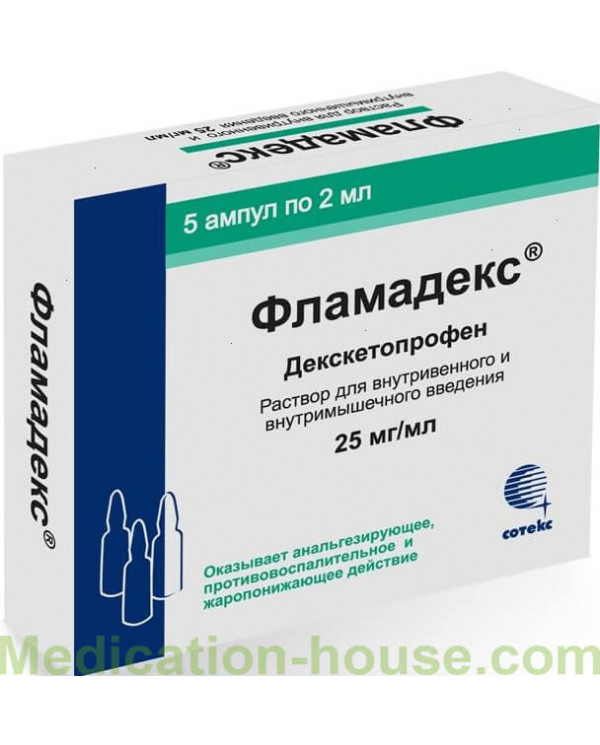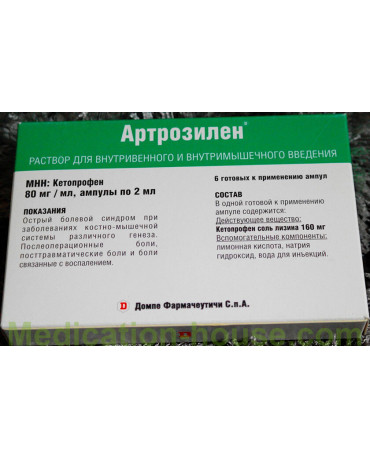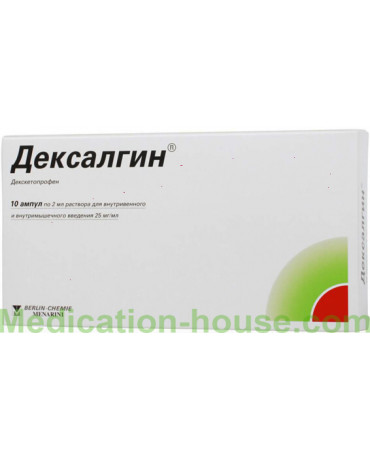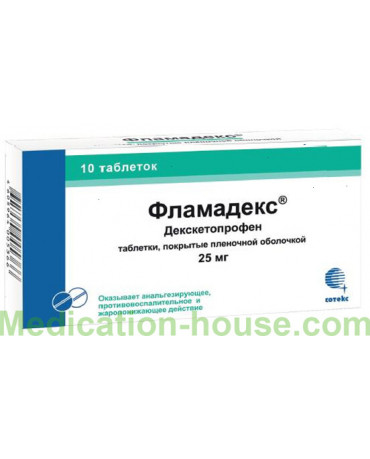Instruction for Flamadex injections
You can buy Flamadex injections on this page
Release form and composition
Solution for parenteral administration Flamadex is a colorless transparent liquid. The main active ingredient of the drug is dexketoprofen trometamol, its content in 1 ampoule (2 ml) is 50 mg. Also in the composition of the solution includes auxiliary components, which include:
Sodium hydroxide.
Ethanol
Sodium disulfite.
Water for injections.
Solution for parenteral administration Flamadex is contained in 2 ml glass ampoules, which are packaged in a blister pack of 5 each. The carton pack contains one blister pack as well as instructions.
Pharmacodynamics
Nonsteroidal anti-inflammatory drug (NSAIDs), a derivative of propionic acid. It has an analgesic, anti-inflammatory and antipyretic effect. The mechanism of action is associated with inhibition of prostaglandin synthesis at the level of cyclooxygenase-1 and cyclooxygenase-2.
Analgesic effect occurs 30 minutes after parenteral administration.
The duration of the analgesic effect after administration at a dose of 50 mg is about 4-8 hours.
When combined with opioid analgesics, dexketoprofen significantly (up to 30-45%) reduces the need for opioids.
Pharmacokinetics
Suction
After intramuscular (IM) administration of dexketoprofen, the maximum concentration (Cmax) in the serum is reached after an average of 20 minutes (10-45 minutes). The area under the "concentration-time" curve (AUC) after a single injection at a dose of 25-50 mg is proportional to the dose for both intramuscular and intravenous (intravenous) administration. The corresponding pharmacokinetic parameters are similar after a single and repeated intramuscular or intravenous injection, which indicates the absence of drug accumulation.
Distribution
Dexketoprofena is characterized by a high level of plasma protein binding (99%). The average value of Vd is less than 0.25 l / kg, the half-time is about 0.35 hours.
Removal
Metabolism of dexketoprofen mainly occurs by conjugation with glucuronic acid, followed by excretion by the kidneys. The half-life (T1 / 2) of dexketoprofen trometamol is about 1-2.7 hours.
Indications for use
The main medical indication for the use of Flamadex injection solution is to reduce the severity of pain syndrome of various origins - trauma, algomenorrhea (painful menstruation) in women, toothache, headache. Also, the drug is used in inflammatory pathology of the structures of the musculoskeletal system - rheumatoid arthritis, ankylosing spondylitis, reactive arthritis.
Contraindications
A number of pathological and physiological conditions of the patient’s body are identified, in which the administration of Flamadex injection solution is contraindicated:
Confirmed increase in the level of potassium in the blood (hyperkalemia).
Erosive and ulcerative pathology of the stomach or duodenum.
Specific sensitivity to nonsteroidal anti-inflammatory drugs ("aspirin triad"), accompanied by the development of asthma, pollinosis of the nose and paranasal sinuses.
Progressive pathology of the kidneys and liver, accompanied by the development of their functional deficiency.
Heart failure in decompensation stage.
Gastrointestinal bleeding, including those suffered in the recent past.
Chronic pathology of the large intestine in the acute stage (Crohn's disease, ulcerative colitis).
The period of rehabilitation after surgery for heart coronary artery bypass surgery.
Various bleeding disorders (hemophilia).
Pregnancy at any time course and lactation.
Patient age up to 18 years.
With caution, the drug is used for peptic ulcer in the stage of clinical and laboratory remission, simultaneous use of drugs that reduce blood clotting, coronary heart disease, specific infections (tuberculosis). Before starting the drug is important to eliminate the presence of contraindications for the patient.
Dosing and Administration
Flamadex solution is intended for parenteral administration. It is administered slowly, deeply intramuscularly in a medical institution in compliance with the rules of asepsis and antisepsis, aimed at preventing the adherence of a secondary bacterial infection.
Recommended dosage for adults: 50 mg every 8-12 hours. If necessary, repeated administration of the drug with a 6-hour interval is possible. The daily dose should not exceed 150 mg.
Flamadex injections are indicated for short-term use, and treatment should be limited to a period of acute symptoms (no more than 2 days).
Liver dysfunction
In patients with mild and moderately impaired liver function (5–9 points on the Child-Pugh scale), the total daily dose should be reduced to 50 mg and frequent monitoring of liver function indicators should be performed. Flamadex should not be prescribed to patients with severe liver dysfunction.
Renal impairment
For patients with mild renal impairment (creatinine clearance - 30-60 ml / min), the daily dose is reduced to 50 mg. Flamadex injections should not be prescribed to patients with moderately severe or severe renal insufficiency (creatinine clearance less than 30 ml / min).
Elderly patients
Dose adjustment for elderly patients is usually not required, but due to the physiological decline in renal function, it is recommended to lower the drug dose: the total daily dose of 50 mg for lung disorders of renal function in elderly patients.
Rules of preparation of the solution
To prepare a solution of injections Flamadex for intravenous infusion, the contents of one ampoule (2 ml) are diluted in 30-100 ml of a 0.9% solution of sodium chloride, glucose solution or Ringer's solution. The solution should be prepared under aseptic conditions, protected from exposure to daylight. The prepared solution should be clear and colorless.
Side effects
Against the background of using the solution for parenteral administration of Flamadex injections, the development of negative pathological reactions from various organs and systems is possible:
The digestive system - nausea, less abdominal pain, diarrhea or constipation, lack of appetite (anorexia), damage to the organs of the gastrointestinal tract and liver.
Nervous system - headache, intermittent dizziness, insomnia or drowsiness, less commonly a violation of skin sensitivity.
Cardiovascular system - a decrease in the level of systemic arterial pressure (arterial hypotension), a feeling of heat, redness of the skin, less often a disturbance of the rhythm and frequency of contractions of the heart.
Sense organs - blurred vision, rarely tinnitus.
Respiratory system - reducing the frequency of respiratory movements (bradypnea), narrowing of the bronchi (bronchospasm).
The urinary system - an increase in the amount of urine (polyuria), renal colic, less inflammation of the kidneys (nephritis).
Musculoskeletal system - muscle spasm, deterioration of joint mobility.
The skin and its appendages - inflammation (dermatitis), excessive sweating, sensitivity to light (photoreaction), the appearance of acne.
Allergic reactions - a rash on the skin, itching, urticaria, angioedema, angioedema, anaphylactic shock, a reaction from the respiratory system.
Local reactions - tissue irritation in the area of the solution.
The appearance of negative pathological reactions is the basis for stopping the injection of Flamadex injection solution or a change in dosage.
Features of use
Before prescribing the solution for parenteral administration of Flamadex injections, the doctor necessarily reads the instructions and draws attention to several features of its correct use:
The drug is used with extreme caution in patients with a history of allergies.
The active component of this drug can lead to a blood clotting disorder.
The drug can interact with drugs of other pharmacological groups, so the doctor should be warned about their possible use.
During the use of the drug, it is recommended to periodically monitor the functional activity of the liver, kidneys, and the state of peripheral blood.
With caution the drug should be used in the elderly.
Each vial of the solution for parenteral administration of Flamadex contains 200 mg of ethanol.
Since after the introduction of the drug may develop negative adverse reactions from the nervous system in the form of drowsiness or dizziness, it is not recommended to perform work associated with the need for increased concentration and speed of psychomotor reactions.
Overdose
In case of a significant excess of the recommended therapeutic dose of Flamadex injections, the appearance or strengthening of negative pathological reactions is possible. In this case, symptomatic therapy is carried out in the hospital.
Proper storage
The shelf life of the solution for parenteral administration Flamadex injections is 2 years. The drug should be stored in a dark, dry place inaccessible to children at an air temperature not higher than + 25 ° C.
Terms of sell
You don't need a prescription to buy Flamadex injections.




